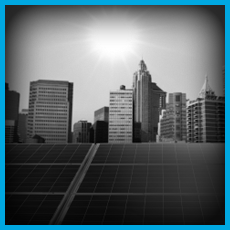OVERVIEW
The term “Distributed Solar” is widely used to describe solar generation systems with a nameplate capacity of not more than 20 MW.1 While Americans have traditionally relied on centralized power, that paradigm is now being challenged by new, more competitively priced distributed generation (DG) technologies. This shift impacts not only the DG user, but also the cost and reliability of the centralized electric grid that everyone is still reliant upon. To meet this new reality, we need new policies that ensure both that the public has access to distributed solar generation and that the costs of maintaining the centralized power system are sufficiently covered.
ANALYSIS
In many areas, businesses using solar panel arrays ranging from 20 watts to 100 kilowatts can generate enough electricity to meet their needs. DG eliminates reliability issues that can arise with moving power from point A to point B, and it is clean.2 These systems often are better able to recover from severe weather and are less susceptible to terrorist events. DG also allows Americans to hedge against rising electricity costs. Since 1999, electricity costs for American homeowners has nearly doubled, from 8.16 cents per kilowatt hour (KWh) to 15.3 cents KWh.3 By 2035, demand for electricity will grow 22%, driving costs up further under a business-as-usual scenario.4
The solar industry estimates that 33 jobs are created from every MW of distributed solar installed.5 While the levelized cost for solar DG remains high, experts note that the continuing reduction in solar panel prices is rapidly making solar competitive with centralized fossil fuels in many parts of the United States.6
Moreover, DG is cleaner than most centralized generation. Every gigawatt of distributed solar installed in the United States avoids an average of 5.8 megatons of carbon emissions.7 If the additional capacity from distributed solar is used to meet added demand, those additional kWh used by the U.S. would avoid a nearly 60 megaton increase in total emissions.
Yet there are tradeoffs in the widespread adoption of distributed solar. Centralized generation may be somewhat less efficient than DG,8 but economies of scale keep the price low. DG systems are often free-riders, relying on the grid to take unused electricity and for backup power, without helping to cover the cost of maintaining the distribution system. As more homes and businesses adopt distributed solar, these challenges will only grow unless the federal government develops policies that balance the benefits of DG with the need to maintain an affordable central grid.
IMPLEMENTATION
In order to increase access to distributed solar power regulatory barriers must be broken down, but must be done so in a balanced way.






